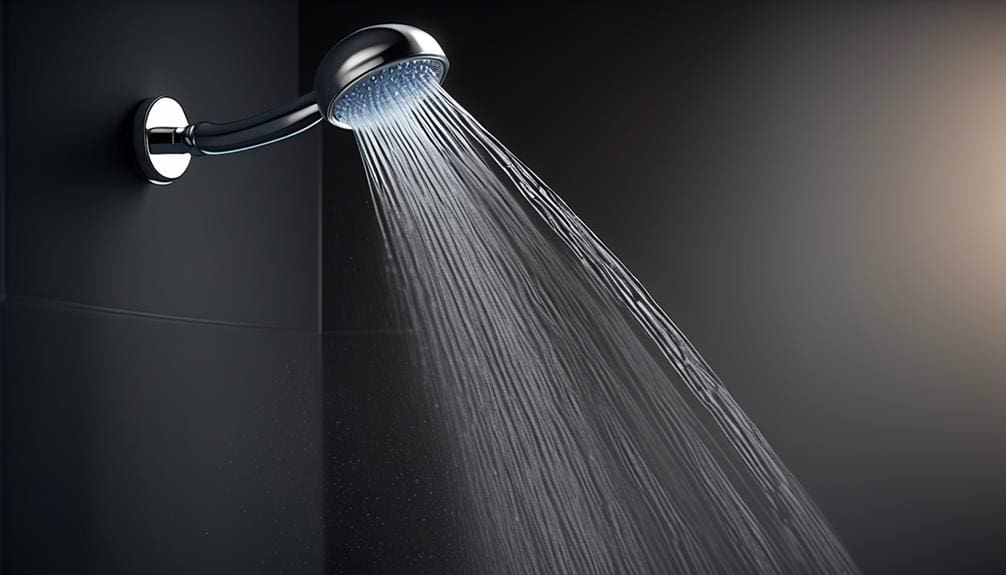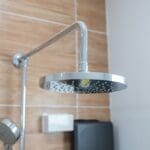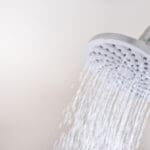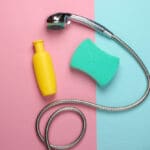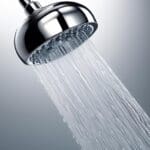Ah, the thrill of standing under a dribble, pretending it’s a rejuvenating waterfall—said no one ever.
If you’re grappling with low shower head pressure, you’re not alone, and it’s not an unsolvable mystery. First off, it’s crucial to understand that various factors can throttle your shower’s vigor, from clogged pipes to the nefarious handiwork of a partially closed valve.
Before you resign yourself to lackluster showers, let’s explore some straightforward steps to reclaim the robust flow you miss. You’ll want to stick around to uncover how simple adjustments or minor DIY fixes can transform your showering experience from a disappointing trickle to a satisfying surge, and when it might be time to call in the cavalry (aka professional help).
Key Takeaways
- Measure flow rate and check for clogs or mineral deposits.
- Address common pressure problems like running multiple appliances simultaneously.
- DIY fixes include installing a shower pump and cleaning pipes with vinegar.
- Call a professional for persistent low pressure, noisy pipes, or visible leaks.
Testing for Low Pressure
To determine if your shower suffers from low pressure, start by measuring the flow rate with a five-gallon bucket. This initial step is crucial in testing for low pressure and understanding how it affects your daily routine. Place the bucket under your shower head and time how long it takes to fill. Calculate the flow rate by dividing the number of gallons by the time it took. If you’re getting less than 2 gallons per minute (GPM), the current U.S. Federal WaterSense standard, you’re experiencing low water pressure.
Several factors can contribute to low shower head pressure, including clogged flow restrictors and mineral deposits. These obstacles can significantly reduce water pressure throughout your home, making even simple tasks frustrating. If you find your flow rate is below the 1.5 GPM mark, which is standard for a low-flow shower head, consider checking these components, especially in older or hand-held shower heads.
To increase water pressure, clean or replace the flow restrictor and remove any mineral deposits. This straightforward maintenance can significantly enhance pressure in the shower, ensuring a more satisfying and efficient experience.
Common Pressure Problems
Several factors can directly impact your shower’s water pressure, causing frustration and inefficiency in your daily routine. If you’re noticing your shower pressure is low, it’s crucial to identify common problems to effectively increase the water pressure. Here are some key issues and solutions:
- Water-Using Appliances: Running multiple water-using appliances simultaneously can significantly reduce shower pressure. Ensure all other fixtures are turned off to help increase shower pressure.
- Peak Water Usage Times: Showering during peak water usage times can lower water pressure. Opting for off-peak hours can naturally increase the water pressure in your home.
- Valve Issues: Insufficient opening of the main shut-off valve or isolation valves can restrict water flow. Double-check to ensure all valves are fully open for maximum pressure shower experience.
- Kinked Shower Hose: A twisted or kinked hose on your handheld shower head hampers water flow. Inspect and straighten or replace the hose to restore optimal flow.
Addressing these common pressure problems can significantly improve your shower experience without needing to immediately resort to installing a pressure regulator or a flow regulator.
DIY Fixes and Tips
If you’re struggling with low shower pressure, various DIY fixes and tips can significantly enhance your shower experience. First, consider installing a shower pump to boost water pressure, offering a more invigorating flow. This can be a game-changer for your daily routine.
If your home is equipped with a water pressure regulator, check and adjust it as needed. Sometimes, simply tweaking this can significantly increase your shower’s water flow rate.
Another effective strategy is to clean your water pipes. Over time, mineral deposits can build up, restricting water flow. Running a solution of white vinegar through the pipes can help dissolve these deposits and improve water flow.
Additionally, removing the flow restrictor from your showerhead is a quick fix to increase water flow. This small device is designed to conserve water, but it can be the culprit behind low pressure.
Lastly, replacing your current showerhead with a low-pressure model designed to operate efficiently under low water pressure conditions can make a noticeable difference. These showerheads are engineered to increase water pressure, ensuring a better shower experience.
With these DIY fixes and tips, boosting your shower’s water pressure is within reach.
When to Call a Professional
While DIY solutions can be effective, there are situations where you’ll need to enlist the expertise of a professional plumber. If you’re struggling with low shower water pressure and can’t seem to increase the pressure despite trying various methods, it might be time to call a professional. They can diagnose issues that are beyond simple fixes and ensure your water pipes are in optimal condition to improve the water pressure.
Here are instances when it’s wise to seek professional help:
- Persistent low pressure despite cleaning or replacing your shower head, indicating deeper issues within your water pipes.
- Noisy pipes which could suggest air in the pipes or worse, a potential leak that could reduce the amount of water reaching your shower and negatively affect the water pressure.
- Visible leaks in the piping that you can’t fix by yourself. A professional can make sure these are properly addressed to help maintain the pressure.
- Water discoloration which could point to corrosion in your pipes, affecting water quality and pressure.
A professional plumber can address these issues, ensuring you don’t just temporarily fix the problem but rather improve the water pressure for the long term.
Optimizing Shower Experience
After exploring when to call a professional for persistent issues, let’s focus on how you can directly enhance your shower experience through practical adjustments.
First, assess your shower’s flow rate using a five-gallon bucket to determine if it meets standard benchmarks. This will give you a clear starting point.
To direct the full flow of water to the shower, ensure all other water-using appliances are turned off during your shower. This simple step can significantly increase the amount of water available to you. Additionally, consider showering during off-hours when water demand in your household is lower, thus boosting water pressure.
Inspect all valves connected to your shower to ensure they’re fully open. This includes checking the main water valve and any inline valves. A partially closed valve can drastically reduce the flow of water to the showerhead.
Lastly, examine the shower hose. Any kinks can restrict water flow, so unkinking or replacing the hose can restore pressure and enhance your shower experience.
Each of these steps targets optimizing the flow and amount of water to your shower, culminating in a significantly improved shower experience.
Frequently Asked Questions
How Can I Make My Shower Head Pressure Stronger?
To make your shower head pressure stronger, check if all valves are fully open, untwist any kinked hoses, shower during off-peak hours, and test the flow rate with a bucket to identify issues.
How Do I Fix Low Water Pressure in My Shower?
To fix low water pressure in your shower, test the flow rate, avoid using other water appliances simultaneously, shower during off-peak hours, ensure valves are fully open, and check the shower hose for kinks.
Why Is Water Barely Coming Out of My Shower Head?
If water’s barely coming out of your shower head, it’s likely due to a clogged nozzle or low overall water pressure. You should check for blockages and ensure all valves are fully open.
How Can I Make My Water Pressure Stronger?
To make your water pressure stronger, install a shower pump, adjust your water pressure regulator, clean the pipes to remove mineral deposits, and remove the flow restrictor. Also, check for leaks and repair them.

